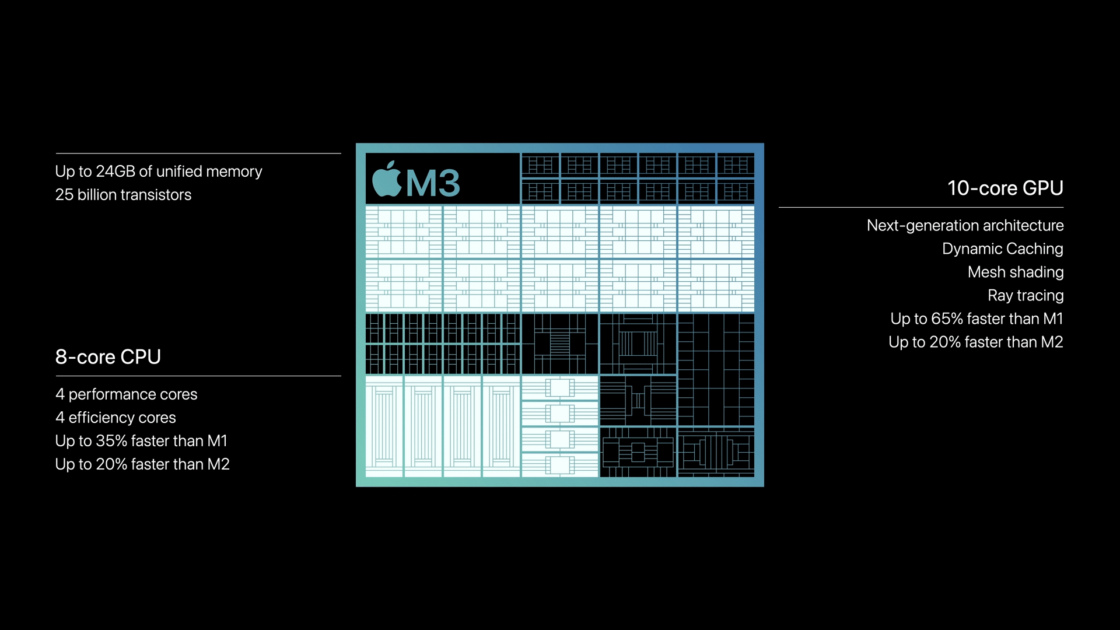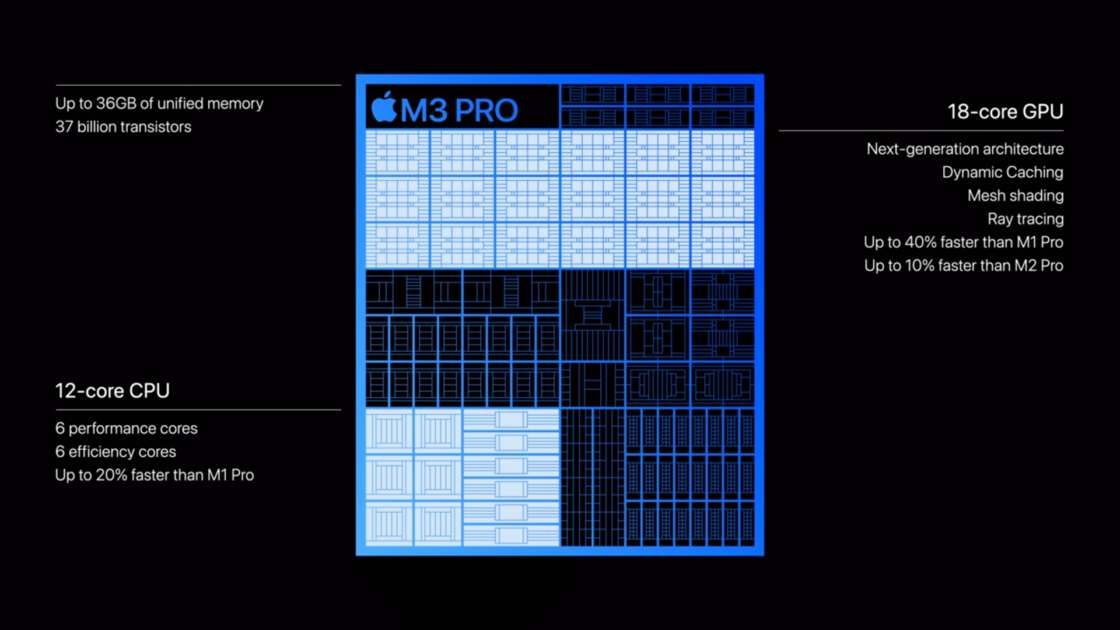In the Scary Fast event on October 30, 2023, Apple announced the next generation of its Apple silicon chips, the M3 family. The M3 family includes three chips: the M3, M3 Pro, and M3 Max. These chips feature hardware-accelerated ray tracing, Mesh shading, Dynamic Caching, and more.
 Apple’s M3 family: Everything you need to know
Apple’s M3 family: Everything you need to know
The M3 family includes three chips: the M3, M3 Pro, and M3 Max. All three chips are built on TSMC’s 3nm process, which is the most advanced chip manufacturing process available at the time. This means that the M3 chips will be more efficient and powerful than the M2 chips, which are built on TSMC’s 5nm process.

Dynamic Caching
One of the key features of the M3 family is M3 Dynamic Caching. M3 Dynamic Caching allows the GPU to dynamically allocate memory as needed. This can free up memory for other applications and improve overall system performance.
Ray Tracing
Another key feature of the M3 family is ray tracing. Ray tracing is a rendering technique that simulates the physical behavior of light to create more realistic images.
Ray tracing is more computationally expensive than traditional rendering techniques, but it can produce much more realistic results. For example, ray tracing can be used to create realistic shadows, reflections, and refractions.
The M3 family has dedicated hardware support for ray tracing, meaning that Macs with M3 chips can perform ray tracing much faster than Macs without dedicated hardware support.
Mesh shading
Mesh shading is a new GPU feature in the M3 chip family. It allows developers to create more detailed and realistic 3D models by shading individual triangles on a mesh, rather than the entire mesh at once. This can lead to significant performance improvements, as well as more realistic lighting and reflections.
Mesh shading is particularly useful for rendering complex scenes with a lot of geometry. For example, it can be used to render large crowds of people or forests with millions of trees. It can also be used to create more realistic materials, such as skin and hair.
Improved performance
Apple says the M3 GPU is up to 65% faster than the M1 GPU for graphics performance. This is a significant improvement, and it will make the M3 chip family ideal for even the most demanding graphics-intensive tasks.
The M3 GPU’s improved performance is due to a number of factors, including:
- A new GPU architecture that is more efficient and powerful than the previous architecture.
- More GPU cores than the previous generation.
- Higher memory bandwidth.
- Hardware-accelerated ray tracing.
The combination of these factors makes the M3 GPU the most powerful GPU ever available in a Mac computer.
Other features
In addition to these new features, the M3 GPU also supports all of the features of the M1 GPU, including:
- Unified memory architecture: This provides a single pool of memory for both the CPU and GPU, which can improve performance for graphics-intensive tasks.
- Custom metal pipelines: These provide a low-level interface to the GPU, which can be used to achieve even better performance for graphics-intensive tasks.
- Wide color support: The M3 GPU supports a wide range of color gamuts, including P3 and Display P3. This allows it to display images and videos with more accurate colors.
Apple claims that the M3 family of chips is more power efficient than the M2 family, thanks to their smaller size and the use of TSMC’s 3nm process. This means that the M3 chips will be able to deliver the same level of performance while using less power, which will result in longer battery life for Macs powered by M3 chips.

M3
The M3 chip has 12 CPU cores and 30 GPU cores. The M3 has a faster CPU clock speed, larger L2 cache, more powerful neural engine, and more efficient power management system. The M3 chip is likely to be used in entry-level Macs.

M3 Pro
The M3 Pro is the mid-range chip that is to be used in more powerful Macs, such as the MacBook Pro and iMac. It has up to 12 CPU cores and 18 GPU cores. This chip is ideal for users who need a Mac that can handle demanding tasks such as video editing, gaming, and professional applications.

The M3 Pro also has dedicated hardware support for video encoding and decoding. This is a significant improvement for Macs that are used for video editing, video streaming, and other video-intensive tasks.
M3 Max
The M3 Max is the highest-end chip that is to be used in the most powerful Macs, such as the Mac Pro and high-end MacBook Pros. It has up to 16 CPU cores and 40 GPU cores.

The M3 Max has dedicated hardware support for video encoding and decoding, and it also supports more external displays than the M3 Pro.
The M3 Max can support up to four external displays with up to 6K resolution and a 60Hz refresh rate. This is more than any other Mac chip, and it makes the M3 Max ideal for users who need to connect multiple external displays.
Performance
Apple has not provided any specific performance benchmarks for the M3 chips, but it has said that they are “scary fast.” This suggests that the M3 chips will be a significant improvement over the M2 chips and that they will make Macs even more powerful and efficient.
Read more: